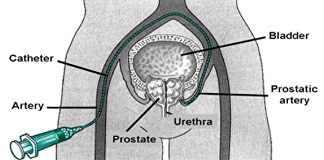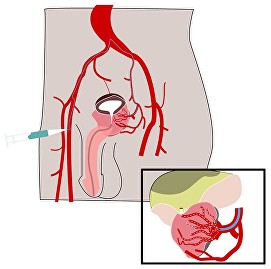Prostate Artery Embolisation
Prostate artery embolisation is a minimally invasive, non-surgical procedure for treating an enlarged and troublesome prostate by blocking off the arteries that feed the gland, causing it to shrink.
Prostate Artery Embolisation for BPH symptoms
Prostate Artery Embolisation (PAE) is a minimally invasive day-case image guided procedure for the treatment of symptoms resulting from benign prostatic hyperplasia (BPH). It is a non-surgical way of treating an enlarged and troublesome prostate by blocking off the arteries that feed the gland and making it shrink.
On this page you will find advice prior to the procedure, a detailed description of the procedure itself, and the aftercare you will receive.
Dr James Briggs and Dr Mark Little are two well-renowned, highly regarded and experienced Consultant Interventional Radiologists who are experts in the field of PAE.
Prostate Artery Embolisation Procedure
Your initial consultation will be with Dr. Little or Dr. Briggs, who are Consultant Interventional Radiologists with a proven track record in PAE. They will discuss the procedure, taking time to explain what you should expect on the day of the procedure, any possible side effects and what to expect during your recovery (see below). Prior to the day of the procedure, you will have a CT scan with contrast to assess your individual arterial anatomy, and to identify the small arteries that supply the prostate gland. This information is essential in order to plan the procedure accurately. At the same visit, you will have an MRI or ultrasound of the prostate (if you are unable to have an MRI scan) to assess the prostate gland itself in more detail.

Dr. Little and or Dr. Briggs will perform your procedure. The procedure does not require a general anesthetic. Local anesthetic is used to numb the skin overlying the artery in your groin. Through an incision no bigger than 5mm, a small plastic tube known as a catheter is placed into the artery in your groin. The catheter is carefully manipulated into the small prostate arteries under x-ray guidance. Once the catheter is in the desired position, a specialist 3D X-ray scan is performed whilst you lie on the x-ray table to confirm correct position. Once the correct position is confirmed, the prostate arteries are blocked by injecting tiny (0.5mm wide) polymer beads. Both right and left prostate arteries are blocked, usually from a single puncture of the artery overlying your right groin.

Scientific research has shown that by blocking the blood supply from these arteries, the prostate gland shrinks, relieving the symptoms of an enlarge prostate gland. The procedure will take approximately 90 minutes. At the end of the procedure, the hole in the artery will be closed using a small dissolvable stitch.
There may occasionally be a small bruise at the site where the needle has been inserted into the artery. There is also a small risk of infection, which is minimized by giving you a short course of oral antibiotics. Most patients feel some mild pain afterwards, which is controlled by simple painkillers. There is a very small risk of the particles used to block the prostate arteries going into nearby arteries, which could result in reduced blood supply to the organs supplied. This is a rare potentially serious complication, reported in fewer than 1 in every 1000 cases. This is why we believe the use of 3D X-ray imaging during the procedure is essential to maximize safety during PAE.
Some patients experience a temporary worsening of their symptoms the first 10 days after the procedure, and around 1 in 50 patients may need a temporary catheter for a day or two during this time, whilst the inflammation in the prostate reduces. Unlike many surgical alternatives, there is no evidence of a negative impact on sexual function following PAE.
PAE has been performed on several thousand patients worldwide, with the largest series coming from Prof Pisco’s group in Lisbon, Portugal. We have successfully reduced symptoms of BPH in >85% of our patients. PAE has also been shown to be beneficial in patients with long-term urinary catheters with successful catheter removal following PAE in >85% of our patients at 2-weeks following the procedure.
Next Steps
Our Prostate Artery Embolisation Specialists
Get fast access to leading specialists for the swift diagnosis and treatment of urological conditions in a private clinic environment.
If you would like more information or wish to arrange a consultation with one of our specialist consultant urological surgeons then please either Call 0118 920 7040 or complete the form below.
Insured patients
Contact your GP and ask for a referral to the Urology Partnership.
All consultations, investigations and treatments are covered by major insurance companies (depending on policy).
Funding your own treatment
Self-funding initial consultation fee is £205. Follow up fees are £165.
Consultation charges are exclusive of any tests and other investigations that the consultant may wish to carry out.

